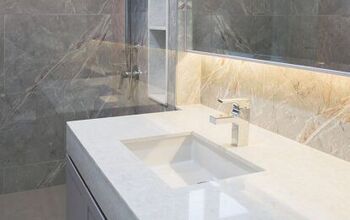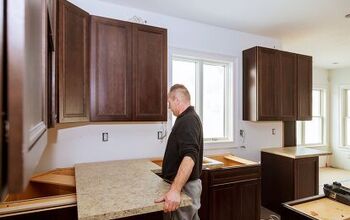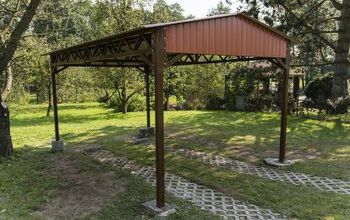Do You Need Plywood Under Quartz Countertop? (Find Out Now!)

Quartz countertops can look beautiful with virtually any decor. But installing them is not for the faint of heart. Quartz is heavy and expensive, and it also needs underlayment. So, do you need plywood under a quartz countertop or not? Here’s the answer.
Whether or not you need plywood underlayment for quartz countertops depends on several things. Thick slabs usually require a solid plywood base to support the weight. However, some thin slabs may need one as well.
Do You Need Countertop Installers?
Get free, zero-commitment quotes from pro contractors near you.

Do You Need Underlayment for Quartz Countertops?
Quartz countertops come in all shapes, sizes, and patterns. But the most popular option is 3cm quartz because it’s durable yet easy to install. You won’t need a plywood base for 2cm – 3cm quartz slabs in most cases. You also won’t need a laminated edge since there’s no plywood to hide.
On the other hand, you must install thicker slabs of quartz over a piece of plywood underlayment. That’s because the extra weight needs support from the additional layer to prevent sagging. So, pay attention to how much your slab weighs and then try to accommodate.
FACT: No major quartz manufacturer requires a plywood underlayment, but many contractors do it out of habit anyway.
Is 2cm or 3cm Quartz Better for Countertops?
The thickness of your quartz countertops affects many things, including your need for plywood. In general, thicker slabs require a solid underlayment, while thinner ones don’t. However, that’s not a steadfast rule. So, both 2cm and 3cm quartz countertops are ideal for quick installation.
Meanwhile, a 3cm countertop can support more weight due to the added girth. That means it’s better for high-traffic areas. But 2cm quartz slabs make excellent countertops too. You might just have to be more careful around the edges since it’s thinner.
How Do You Hide Plywood Under Quartz Countertops?
Hiding a plywood underlayment beneath your quartz countertops is easier than you think. And that’s especially true if you use 2cm slabs. Many homeowners install 2cm quartz countertops without plywood to save time and money. So, they end up with nothing to hide.
However, homeowners who choose thicker quartz countertops may have a different experience. The added thickness is beautiful and, if you keep it below 3cm, may not need a plywood backing either. But what about when you attach underlayment anyway? How do you hide it?
The most popular option for hiding plywood underlayment on quartz countertops is laminate. You can laminate the edges with matching material to protect weak spots and extend the life of your materials. Still, laminate edges may create an appearance that some homeowners don’t prefer.
TIP: You can always try to paint plywood a coordinating color before installing it to hide underlayment for cheaper.
How Are Quartz Countertops Attached to Cabinets?
You install quartz countertops one at a time, so start with the closest section to the sink. First, install any underlayment you’ve decided to use to the tops of the cabinets. If you use glue instead of nails, let it cure, so the plywood doesn’t move when you’re on the next step. If you’re not using underlayment, skip this part.
Now, add a line of silicone adhesive beads along the border of your exposed cabinet top. Make sure the dots are spaced about six (6) to twelve (12) inches apart. And try to use the best sealants for quartz countertops, or else your hard work may be for nothing.
Remember, some cabinets may not be strong enough to support heavy quartz slabs plus a plywood underlayment. So, don’t let your countertop overhang too much without adequate support.
Are My Cabinets Strong Enough for Quartz?
Your cabinets may be beautiful, but that doesn’t mean they’re strong enough to support dense quartz countertops. In addition, you might have a few weak spots in your cabinetry around the open and unsupported areas. Places like desks and overhangs are notorious for needing extra support.
That’s why many homeowners decide to use a plywood underlayment regardless of how thick their quartz countertops are. A thin layer of plywood can help support holes and weak spots, even those you don’t see. You can also use plywood to fortify particular walls and make them stronger.
Support Your Quartz
Quartz countertops can be heavy, and they get heavier as they get thicker. Meanwhile, your cabinets may or may not be strong enough to support the weight. So, use plywood underlayment to strengthen the surface and enjoy years of beautiful craftsmanship.
Do You Need Countertop Installers?
Get free, zero-commitment quotes from pro contractors near you.

Related Questions
How Much Support Does a Quartz Countertop Need?
As a general rule, about 70% of your quartz countertops need adequate support. That means you can let about 30% of the slab hang over the edge without causing problems. However, you should always use more than adhesive if you’re planning an overhang.Usually, you’ll need corbels, posts, or brackets to secure the slab. But the thickness of your quartz countertop matters as well. For example, thinner slabs may support a larger overhang since they weigh a lot less.
What Is the Best Adhesive for Quartz?
Try to secure your quartz countertops with the best silicone or epoxy adhesive. And if you’re trying to coordinate colors or hide plywood underlayment, use a pigmented brand. For the best results, use a dye that’s similar to your countertops so that everything blends.
Does Quartz Crack Easily?
People choose quartz for their countertops because it’s both beautiful and durable. Quartz is also crack-resistant, and it becomes more robust the thicker it is. However, lower-quality quartz slabs can crack or shatter when exposed to extreme hot or cold temperatures. So, try not to place hot pans or cold bags of ice on your quartz countertops without protection.
Related Guides

Tiffany Nichols specializes in aesthetics, design, marketing, and manufacturing. She's a copywriter and editor for several home renovation companies in the U.S. and works alongside some of the biggest names in the industry. Her hobbies include architecture, art, mental health, and fashion.
More by Tiffany Nichols























![Standard Dining Room Table Dimensions [for 4, 6, 8, 10 and 12 People]](https://cdn-fastly.upgradedhome.com/media/2023/07/31/9074335/standard-dining-room-table-dimensions-for-4-6-8-10-and-12-people.jpg?size=350x220)



